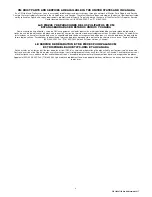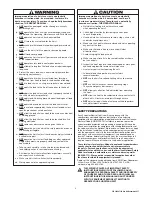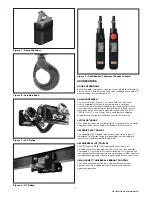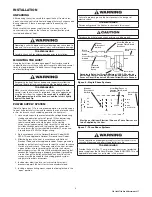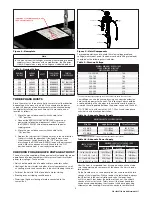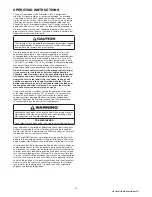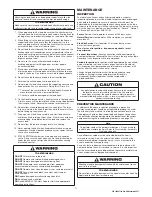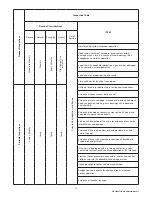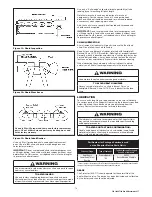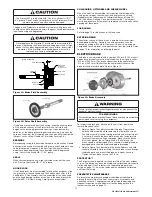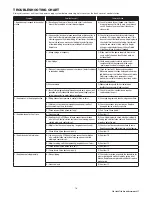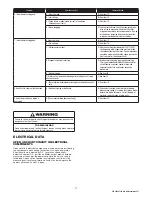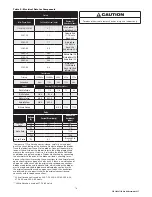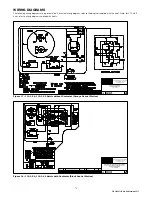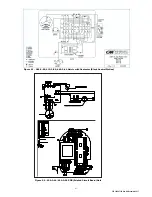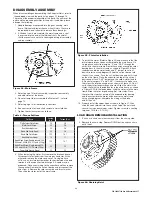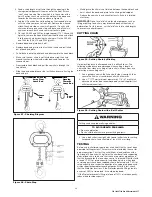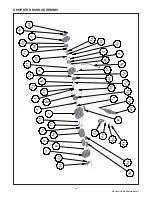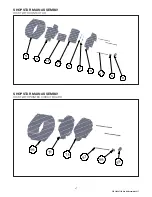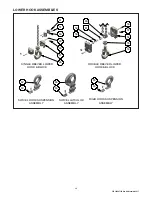
13
P/N 192047138 Rev AA November 2017
HOOK INSPECTION
Hooks damaged from chemicals, deformations or cracks, or any
visibly apparent bend or twist from the plane of the unbent hook,
excessive opening or seat wear must be replaced. Also, hooks
that are opened and allow the latch to not engage the tip must be
replaced. Any hook that is twisted or has excessive throat opening
indicates abuse or overloading of the unit. Inspect other load
sustaining parts, hook block screws, load pins and hook block
bodies for damage.
On latch type hooks, check to make sure that the latch is not
damaged or bent and that it operates properly with sufficient spring
pressure to keep the latch tightly against the tip of the hook and
allow the latch to spring back to the tip when released. If the latch
does not operate properly, it should be replaced. See Figure 8 to
determine when the hook must be replaced.
Suspension bolts should be replaced any time the suspension
is removed from the hoist.
HOOK REPLACEMENT CRITERIA
Based on ASME B30.10, hooks shall be removed from service if
damage such as the following is visible and shall only be returned
to service when approved by a qualified person:
1. Missing or illegible rated load identification or illegible
hook manufacturers’ identification or secondary
manufacturer’s identification.
2. Excessive pitting or corrosion. Cracks, nicks, or gouges.
3. Wear--any wear exceeding 10% of the original section
dimension of the hook or its load pin.
4. Deformation--any visibly apparent bend or twist from the
plane of the unbent hook.
5. Throat opening-any distortion causing an increase in the
throat opening of 5% not to exceed 1/4” (6mm).
6. Inability to lock- any self-locking hook that does no lock.
7. Inoperative latch, any damaged latch or malfunctioning
latch that does not close the hook’s throat.
8. Thread wear, damage, or corrosion.
9. Evidence of excessive heat exposure or unauthorized welding.
10. Evidence of unauthorized alterations such as drilling,
machining, grinding, or other modifications.
INSPECTING THE LOAD CHAIN
The chain must be inspected at regular intervals, with a minimum
of once annually. As the frequency of use increases, the time
Intervals between inspections must be reduced. During inspection,
the chain link must be examined along their entire length, including
the hidden parts. If the lifting equipment is frequently used with a
constant lifting distance or in other words the switch from upward to
downward often takes place in the same area, a particularly thorough
inspection and lubrication is required in that area. Worn chain can
also be an indication of worn hoist components. For this reason, the
hoist’s chain guides, hook blocks and liftwheel (sprocket) should be
examined for wear and replaced as necessary when replacing chain.
1. Check to see if chain is dirty or poorly lubricated.
2. Clean the chain with a non-caustic/non-acid type solvent
and make a link by link inspection for wear or cracks in the
links, twisted or deformed links. Chain with any one of these
defects must be replaced.
3. Slack the portion of the chain that normally passes over
the lift-wheel (sprocket) or idler sprocket on multi-reeved
hoist. Examine the chain links for wear. If the wire diameter
anywhere on the link measures less than 90% of the nominal
wire diameter, the chain must be replaced.
4. Based upon ASME B30.16, should also be checked for
elongation. Select an unworn, un-stretched length of the
chain (at the slack end for example). Suspend the chain
vertically under tension and using a knife blade caliper
type gauge, measure the outside length of any convenient
number of links, 11 is recommended. Measure the same
number of links in the used sections and calculate the
percentage in increased length. The chain should be
replaced if the length of the used portion is more than
1.5% longer than the unused portion of the chain. Also,
if the pitch of any individual link has elongated by more
than 5%, the chain should be replaced.
Figure 10 - Hook Inspection
Latch Type Hook
Latchlok® Hook
“A” Max
“B” Min
“A” Max
“B” Min
1.12” (28.5mm)
.71” (18.0mm)
1.48” (37.7mm)
.75” (18.8mm)


